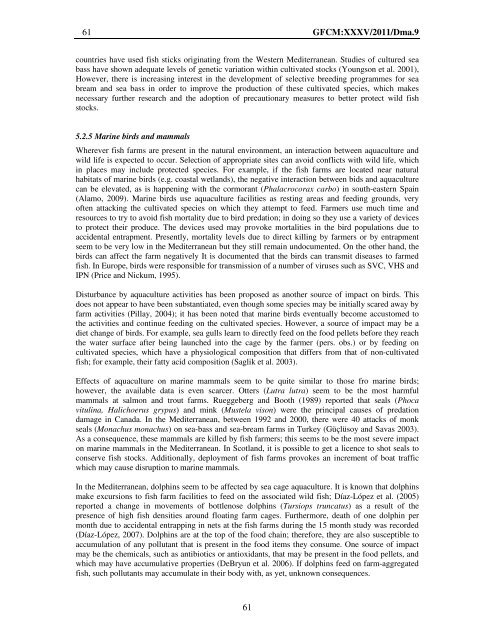Site selection and carrying capacity in Mediterranean ... - FAO Sipam
Site selection and carrying capacity in Mediterranean ... - FAO Sipam
Site selection and carrying capacity in Mediterranean ... - FAO Sipam
Create successful ePaper yourself
Turn your PDF publications into a flip-book with our unique Google optimized e-Paper software.
61 GFCM:XXXV/2011/Dma.9<br />
countries have used fish sticks orig<strong>in</strong>at<strong>in</strong>g from the Western <strong>Mediterranean</strong>. Studies of cultured sea<br />
bass have shown adequate levels of genetic variation with<strong>in</strong> cultivated stocks (Youngson et al. 2001),<br />
However, there is <strong>in</strong>creas<strong>in</strong>g <strong>in</strong>terest <strong>in</strong> the development of selective breed<strong>in</strong>g programmes for sea<br />
bream <strong>and</strong> sea bass <strong>in</strong> order to improve the production of these cultivated species, which makes<br />
necessary further research <strong>and</strong> the adoption of precautionary measures to better protect wild fish<br />
stocks.<br />
5.2.5 Mar<strong>in</strong>e birds <strong>and</strong> mammals<br />
Wherever fish farms are present <strong>in</strong> the natural environment, an <strong>in</strong>teraction between aquaculture <strong>and</strong><br />
wild life is expected to occur. Selection of appropriate sites can avoid conflicts with wild life, which<br />
<strong>in</strong> places may <strong>in</strong>clude protected species. For example, if the fish farms are located near natural<br />
habitats of mar<strong>in</strong>e birds (e.g. coastal wetl<strong>and</strong>s), the negative <strong>in</strong>teraction between bids <strong>and</strong> aquaculture<br />
can be elevated, as is happen<strong>in</strong>g with the cormorant (Phalacrocorax carbo) <strong>in</strong> south-eastern Spa<strong>in</strong><br />
(Alamo, 2009). Mar<strong>in</strong>e birds use aquaculture facilities as rest<strong>in</strong>g areas <strong>and</strong> feed<strong>in</strong>g grounds, very<br />
often attack<strong>in</strong>g the cultivated species on which they attempt to feed. Farmers use much time <strong>and</strong><br />
resources to try to avoid fish mortality due to bird predation; <strong>in</strong> do<strong>in</strong>g so they use a variety of devices<br />
to protect their produce. The devices used may provoke mortalities <strong>in</strong> the bird populations due to<br />
accidental entrapment. Presently, mortality levels due to direct kill<strong>in</strong>g by farmers or by entrapment<br />
seem to be very low <strong>in</strong> the <strong>Mediterranean</strong> but they still rema<strong>in</strong> undocumented. On the other h<strong>and</strong>, the<br />
birds can affect the farm negatively It is documented that the birds can transmit diseases to farmed<br />
fish. In Europe, birds were responsible for transmission of a number of viruses such as SVC, VHS <strong>and</strong><br />
IPN (Price <strong>and</strong> Nickum, 1995).<br />
Disturbance by aquaculture activities has been proposed as another source of impact on birds. This<br />
does not appear to have been substantiated, even though some species may be <strong>in</strong>itially scared away by<br />
farm activities (Pillay, 2004); it has been noted that mar<strong>in</strong>e birds eventually become accustomed to<br />
the activities <strong>and</strong> cont<strong>in</strong>ue feed<strong>in</strong>g on the cultivated species. However, a source of impact may be a<br />
diet change of birds. For example, sea gulls learn to directly feed on the food pellets before they reach<br />
the water surface after be<strong>in</strong>g launched <strong>in</strong>to the cage by the farmer (pers. obs.) or by feed<strong>in</strong>g on<br />
cultivated species, which have a physiological composition that differs from that of non-cultivated<br />
fish; for example, their fatty acid composition (Saglik et al. 2003).<br />
Effects of aquaculture on mar<strong>in</strong>e mammals seem to be quite similar to those fro mar<strong>in</strong>e birds;<br />
however, the available data is even scarcer. Otters (Lutra lutra) seem to be the most harmful<br />
mammals at salmon <strong>and</strong> trout farms. Rueggeberg <strong>and</strong> Booth (1989) reported that seals (Phoca<br />
vitul<strong>in</strong>a, Halichoerus grypus) <strong>and</strong> m<strong>in</strong>k (Mustela vison) were the pr<strong>in</strong>cipal causes of predation<br />
damage <strong>in</strong> Canada. In the <strong>Mediterranean</strong>, between 1992 <strong>and</strong> 2000, there were 40 attacks of monk<br />
seals (Monachus monachus) on sea-bass <strong>and</strong> sea-bream farms <strong>in</strong> Turkey (Güçlüsoy <strong>and</strong> Savas 2003).<br />
As a consequence, these mammals are killed by fish farmers; this seems to be the most severe impact<br />
on mar<strong>in</strong>e mammals <strong>in</strong> the <strong>Mediterranean</strong>. In Scotl<strong>and</strong>, it is possible to get a licence to shot seals to<br />
conserve fish stocks. Additionally, deployment of fish farms provokes an <strong>in</strong>crement of boat traffic<br />
which may cause disruption to mar<strong>in</strong>e mammals.<br />
In the <strong>Mediterranean</strong>, dolph<strong>in</strong>s seem to be affected by sea cage aquaculture. It is known that dolph<strong>in</strong>s<br />
make excursions to fish farm facilities to feed on the associated wild fish; Díaz-López et al. (2005)<br />
reported a change <strong>in</strong> movements of bottlenose dolph<strong>in</strong>s (Tursiops truncatus) as a result of the<br />
presence of high fish densities around float<strong>in</strong>g farm cages. Furthermore, death of one dolph<strong>in</strong> per<br />
month due to accidental entrapp<strong>in</strong>g <strong>in</strong> nets at the fish farms dur<strong>in</strong>g the 15 month study was recorded<br />
(Díaz-López, 2007). Dolph<strong>in</strong>s are at the top of the food cha<strong>in</strong>; therefore, they are also susceptible to<br />
accumulation of any pollutant that is present <strong>in</strong> the food items they consume. One source of impact<br />
may be the chemicals, such as antibiotics or antioxidants, that may be present <strong>in</strong> the food pellets, <strong>and</strong><br />
which may have accumulative properties (DeBryun et al. 2006). If dolph<strong>in</strong>s feed on farm-aggregated<br />
fish, such pollutants may accumulate <strong>in</strong> their body with, as yet, unknown consequences.<br />
61
















